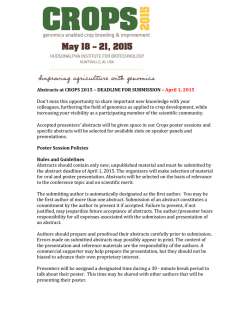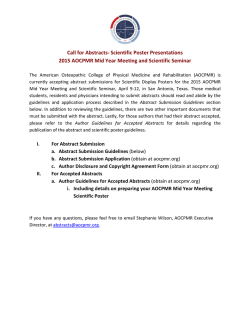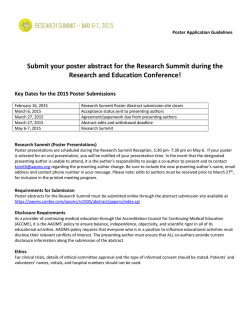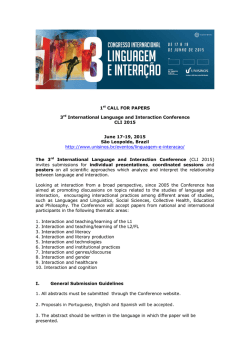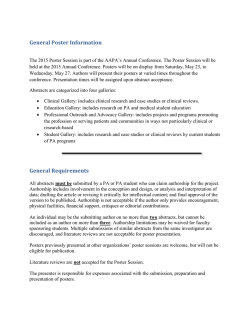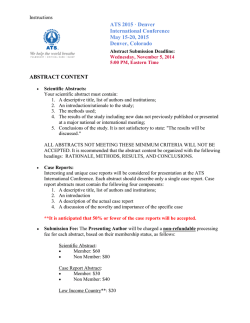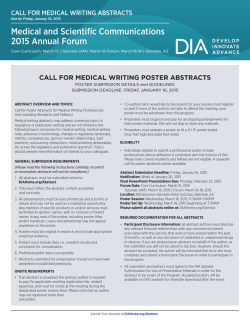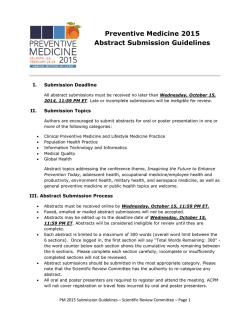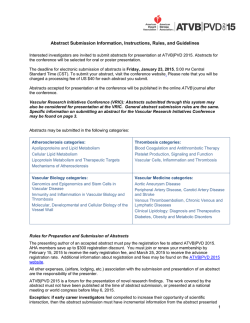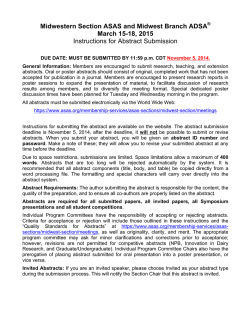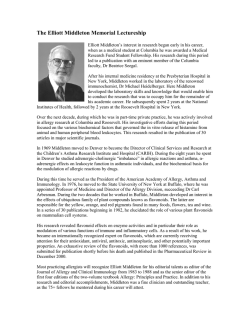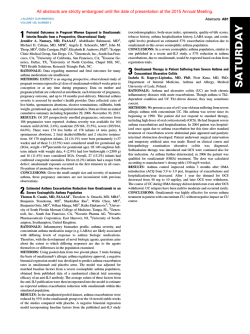
Abstract Submission Guidelines 2015
2015 American Academy of Allergy, Asthma & Immunology Abstract Submission Policies and Procedures Please read carefully All authors must follow the policies and procedures set forth by the American Academy of Allergy, Asthma & Immunology (AAAAI) in order for their abstract to be reviewed and considered for acceptance for presentation at the 2015 AAAAI Annual Meeting. 1.0 Abstract Submission 1.1) Submission Deadline. Please review the content of your abstract for accuracy. It is the responsibility of the submitting author to ensure accuracy of content. Abstracts must be received by September 8, 2014, at 11:59pm Central Time, in their final form, including the author listing. Absolutely no abstracts or abstract changes, including author additions, name revisions or a revised listing order will be accepted after the submission deadline. 1.2) Previous Presentations of Abstracts. Only original abstracts will be accepted. Abstracts previously accepted and published by other organizations/societies will not be accepted. If an abstract submitted to the AAAAI is accepted for programming and publication by another organization prior to its acceptance by the AAAAI, it is the author’s responsibility to withdraw the abstract. Failure to do so may result in being eliminated from future abstract programming consideration. 1.3) Abstract Authors. Abstracts may be submitted by fellows, members and non-members of the AAAAI. An individual may be the first/primary author of only one abstract at the 2015 AAAAI Annual Meeting. Sponsorship or co-authorship of additional abstracts is permitted. 1.4) Abstract Preparation. If accepted for presentation, the first/primary author is the individual who must present the abstract. Please be sure that all contact information is accurate. An individual may present only one abstract at the 2015 AAAAI Annual Meeting. A speaker who is invited to present at a plenary, symposium, Interest Section Forum, course, workshop or seminar does not lose the privilege of presenting an abstract, provided that an abstract is neither Revised April, 2014 1 submitted nor required for the invited presentation and that each presentation is substantially and recognizably different from the other in concept and data. 1.5) Duplicate Abstracts. In an effort to reduce the amount of duplicate abstracts submitted, only one abstract per clinical study will be allowed from any one laboratory, institution, or group of investigators. Abstracts summarizing significantly different aspects and presenting significantly different conclusions using the same study population will be allowed, but multiple abstracts focusing on the same or slightly different aspects of the same study are prohibited. Authors are required to give the clinicaltrials.gov identifier which assures that the trial was registered with clinicaltrials.gov. The protocol number assigned by the sponsor is also required. *Please answer all of the protocol questions completely. If there is a protocol or clinical trial number relevant to the study, it must be provided or the abstract may be removed from consideration. 1.6) Topic Categories and Keywords. Each abstract must be submitted with one topic category and up to three keywords, chosen by the submitting author. This information will be used to assist in the systematic review and organization of abstracts and their subsequent presentations. Abstract submitters should provide the appropriate notations on the online submission form. Abstracts submitted without this information will not be reviewed for presentation at the 2015 AAAAI Annual Meeting. 1.7) Funding. The source of funding of the research summarized in the abstract must be disclosed at the time of submission. Abstract submitters must provide this information in the appropriate section of the online submission form. 1.8) Submission Fee. Each abstract submission must be accompanied by a $50 processing fee. Payment must be made by credit card. Complete the credit card information on the online submission form. Abstracts received without payment will not be considered for presentation at the 2015 AAAAI Annual Meeting. The abstract submission fee is not refundable, even if the abstract is not accepted. 1.9) Abstract Withdrawals and Revisions. Withdrawals must be received in writing at the AAAAI executive office by December 1, 2014. Please review your submission carefully to be sure all appropriate data and all authors are listed and in the correct order. Absolutely no new information or revisions to content, data or the author block will be accepted after the submission deadline of September 8, 2014, 11:59pm Central Time. It is the responsibility of the submitting author to ensure accuracy of content, spelling and author block (including listing order). Abstracts are directly extracted from the submission Revised April, 2014 2 database for publication. Accepted abstracts will be published in The Journal of Allergy and Clinical Immunology (JACI) exactly as submitted. 2.0 Organization of Abstract Body 2.1) The organization of the abstract should include the following specifications: A) Rationale: A brief statement of purpose of the study and the hypothesis to be tested (preferably 1-2 sentences). B) Methods: Summarize the predictors and outcomes analyzed, as well as the methods used. For abstracts reporting clinical research, a sentence or phrase presenting the most important selection criteria for subjects should be included. C) Results: Provide a summary of the results including quantitative data, presented in sufficient detail with statistical analysis when possible to support the conclusions. D) Conclusions: Summarize the impact and significance of the findings. It is not satisfactory to state, "The results will be discussed," or "other data will be presented," etc. Be sure to use the words “Rationale, Methods, Results and Conclusions” in the body of your abstract to indicate the start of each new section. See the Sample Abstract example included in this document. Author information should not be included in the body of the abstract. 2.2) Abstract Length. The maximum length of an abstract submitted for presentation at the 2015 Annual Meeting is 250 words. Use of the words “Rationale, Methods, Results and Conclusions” as described above will not count towards the 250 word total. 2.3) Tables and graphs are not permitted. 2.4) Title. Capitalize only the first letter of each word of the title. 2.5) Abbreviations. The use of standard abbreviations is desirable (i.e., rbc, kg, mg). A special or unusual abbreviation should be placed in parentheses after the first appearance of the full word for which it represents. Do not use periods after abbreviations or initials. Numerals rather than words should indicate numbers, except to begin sentences. 2.6) Drug Names. Non-proprietary (generic) names are preferred and should be used in the title of the abstract. Generic drug names are not capitalized in the body of the abstract. If a proprietary drug name is used in the body of the abstract, the first letter is capitalized. Revised April, 2014 3 2.7) Format. You may use your word processor’s capabilities for bold, underline, italic, subscript and superscript, or use the tools provided when entering your abstract. Bold the words Rationale, Methods, Results and Conclusions used to separate one section of the abstract from another. Text that will be in italics in published form (e.g., genus, species) may be formatted as italics. 2.8) Revisions. You may come back to the site and edit your abstract until the submission deadline of September 8, 2014 at 11:59pm Central Time. After the submission deadline, no further revisions will be allowed. 2.9) Review. Abstracts will be graded by several reviewers on the following criteria; Clinical or basic science significance, Methodology and as an Overall submission. Reviewers are also asked to flag abstracts that involve human subject’s research or animals if the corresponding approvals are missing. If accepted for presentation, Abstracts will appear in the JACI supplement exactly as submitted, including the author listing as submitted by the submission deadline of September 8, 2014 at 11:59pm Central Time. Sample Abstract (1) Bisphenol-A Exposure and Asthma In An Inner-City Birth Cohort (2) K. M. Donohue1, R. L. Miller2, M. S. Perzanowski2, A. C. Just2, L. A. Hoepner2, S. Arunajadai3, F. P. Perera2, R. M. Whyatt2; 1 Columbia Presbyterian Medical Center, New York, NY, 2Department of Environmental Health Sciences, Mailman School of Public Health, Columbia University, New York, NY, 3Department of Biostatistics, Mailman School of Public Health, New York, NY. (3) Rationale: Bisphenol-A (BPA) is an endocrine disruptor widely used in food containers. Prenatal exposure to BPA has been associated with airway inflammation in a mouse model. We hypothesized that exposure to BPA would be associated with increased odds of asthma during childhood. Methods: The Columbia Center for Children’s Environmental Health recruited 322 pregnant women for a prospective birth cohort study. Spot urine samples were collected and total urinary BPA level was analyzed via mass spectrometry. Board-certified allergists conducted standardized exams and pulmonary function tests to determine current asthma status using pre-specified criteria. At the time of the exam, children were age 5 to 12 years. Logistic regression was used for analyses. Models controlled for gender, race/ethnicity, maternal asthma, exposure to pre- and post-natal environmental tobacco smoke, and urinary specific gravity. Results: Urinary BPA levels at ages three and five years were associated with increased odds of asthma (n=280, OR 1.49, 95%CI (1.10 to 2.03), p = 0.009; n=322, OR 1.31, 95%CI (0.99 to 1.74), p = 0.05, respectively). Conclusions: Exposure to BPA during childhood is associated with increased risk of asthma in a prospective, population-based birth cohort. (1) = Title (2) = Author Block; 1st Author is the primary/submitting author. It is assumed this is whose contact information is provided for notification (3) = Abstract Body; 250 word count, not including author, abstract title, author block, and the words: Rationale, Methods, Results and Conclusion Revised April, 2014 4 All case reports that include novel findings or important educational lessons will be considered for presentation. Descriptions of routine cases or common conditions will not be accepted for oral or poster presentation. Below is an example of a case report that was submitted for the 2011 Annual Meeting that fulfills the criteria for an acceptable case report. Sample of Accepted Case Report (1) A young child with Hyper IgE Syndrome (HIES) with a Novel Variant in signal transduction and activator of transcription 3 (STAT3) and Disseminated Histoplasmosis W. Robinson1,2, J. Vickery1,2, C. Michael1,2, S. Arnold1,2, R. Schoumacher1,2, R. Chesney1,2, K. Lakin1,2, J. Ward1,2, E. Pivnick1,2, D. Lew1,2; 1 Children's Foundation Research Center at the Le Bonheur Children's Hospital, Memphis, TN, 2University of Tennessee Health Science Center, Memphis, TN.(2) M. Vasudev, M. Reddy, A. Kumar, R. J. Noel, J. J. Nocton, J. Verbsky, W. J. Grossman; Medical College of Wisconsin, Milwaukee, WI. (3) RATIONALE: Type 1 HIES is an autosomal dominant disorder due to defects in STAT3 signaling and Th17 differentiation. Onset is usually during infancy but diagnosis is often made in childhood or later. Disseminated histoplasmosis in HIES is rare and unreported in children. Here we present a child with disseminated histoplasmosis found also to have a novel STAT3 variant. METHODS: DNA PCR and sequencing of STAT3 were performed by Correlagen Diagnostics. RESULTS: This patient with wiry hair and square asymmetric face, was initially hospitalized at 5 months for pneumonia, multiple fractures, eczema, wheezing and milk allergy. IgE 187 IU/mL, IgA <6.3 mg/dL, and eosinophil count 3,500/mm3. IgG, IgM, lymphocyte mitogen stimulation and cell surface markers were normal. IgA normalized but he worsened clinically manifesting developmental delay, osteopenia, femur/tibial fractures, progressive dysphagia/aspiration pneumonia, and pneumococcal pneumonia/empyema/pneumatocele. He presented at 2.75 years with hepatosplenomegaly, respiratory distress, progression of HIES clinical score (51), yeast in BAL consistent with Histoplasma capsulatum, elevated urine and blood histoplasma antigen, IgE 1,106 IU/mL and flat pneumococcal titers. Subsequently, he responded to Prevnar13 vaccination. STAT3 analysis revealed a missense mutation in exon 20 within the SH2 domain [c.1772A>T, amino acid change p.Lys591Met]. He responded well to amphotericin B followed by itraconazole therapy. He will remain on suppressive antifungal and bactrim indefinitely. CONCLUSIONS: We believe this is the first reported case of disseminated histoplasmosis in a child with HIES. Our patient's missense mutation has not been previously reported. This novel STAT3 variant in SH2 domain may be instructional for clinical course and prophylaxis strategies. (1) = Title (2) = Author Block; 1st Author is the primary/submitting author. It is assumed this is whose contact information is provided for notification (3) = Abstract Body; 250 word count, not including author, abstract title, author block, and the words: Rationale, Methods, Results and Conclusion 3.0 Abstract Acceptance 3.1) Notification of Programming. If the abstract is accepted for presentation at the 2015 AAAAI Annual Meeting, the submitting author will be notified via email the week of November 24, 2014. Only the submitting author will be notified of abstract programming. Please make sure all contact information is accurate. Such notification will include: (1) Title of session for abstract presentation; (2) Date and time of session; and (3) Format of presentation (oral or poster). Abstracts scheduled for presentation will be grouped by topic, numbered and listed in the program, and published in the abstract supplement. Under no circumstances will changes be made to this schedule. Revised April, 2014 5 3.2) Disclosure Policy. Reviewed and Approved by the Board of Directors, November 6, 2010 Pursuant to the Code of Ethics for the American Academy of Allergy, Asthma and Immunology (AAAAI) and the Standards for Commercial Support of Continuing Medical Education of the Accreditation Council for Continuing Medical Education, the AAAAI requires disclosure of financial and organizational relationships from the following types of individuals: 1. Leaders (officers, Board members, JACI editors, committee chairs/members, and staff); 2. Faculty for scientific meetings and conferences (planning committee members, moderators, and speakers); 3. Participants (at business/committee meetings or other member forums, including involvement in public discourse at scientific meetings and conferences); and 4. Authors of official AAAAI documents. Disclosure by Leaders must be made in writing via the Online Disclosure System. A completed form must be completed prior to the commencement of a Leader’s term of office. Such disclosure must be updated whenever circumstances require or once per calendar year, whichever is sooner. Disclosure by Faculty must be made in writing via the Online Disclosure System. A completed form must be completed prior to the beginning of the Faculty member’s involvement in planning or, if a speaker or abstract presenter, before his/her presentation at an AAAAI-sponsored educational activity. Such disclosure must be updated whenever circumstances require or once per calendar year, whichever is sooner. Further, faculty must disclose to the AAAAI in advance any support they receive or plan to receive in the formulation and development of their presentation. Such support must be approved in advance by the AAAAI. Faculty who are also speakers must also disclose verbally and visually at the beginning of each presentation. This should be done by the use of a slide or slides containing the information on the disclosure form. Speakers are also required to disclose to participants discussion of investigational products or investigational uses of products included in their presentations. Disclosure by Participants must be made verbally at the time a Participant begins speaking at each business/committee meeting or other member forum they attend. Participants are required to disclose their job title and employer, and any other interest of theirs that would be judged by a majority of their peers to be more than casual and/or likely to impact their ability to exercise independent judgment in addressing the issue being discussed. Disclosure by Authors must be made in writing via the Online Disclosure System. A form must be completed prior to the author beginning work on an AAAAI position statement. All competing relationships should be disclosed. This information will be reviewed to identify conflicts of interest and to guide the resolution of those conflicts. For Leaders, reviews will be completed by an appropriate AAAAI committee or executive body. For Faculty, reviews will be completed by the Continuing Medical Education Committee or the Annual Meeting Program Committee, depending on the activity in which the faculty member will potentially be involved. Revised April, 2014 6 For Authors, reviews will be completed by the Practice Diagnostics and Therapeutics Committee. Persons whose personal financial gain from Commercial Interests represents a significant portion of their total income may not be appropriate AAAAI leaders, faculty or authors. In general, a relationship is likely to be deemed inappropriate if it is beyond what a general AAAAI member or the general public would consider proper. Commercial Interest A commercial interest is defined as any entity producing, marketing, re-selling, or distributing health care goods or services consumed by, or used on, patients. A medical practice is not considered to be a Commercial Interest If the individual’s employer fits the definition of a commercial interest, the individual should describe the scope of his or her work responsibilities (such as administration of specific programs or the topic of research activities). If the individual’s employer receives remuneration from a commercial interest for the individual’s activities, this relationship should also be disclosed. Failure to knowingly disclose potential conflicts is a violation of the AAAAI’s Code of Ethics and such infringements will be dealt with as detailed in section III.B of the Code of Ethics. Competing Relationships Examples of competing relationships include: 1. Financial relationship with a commercial interest (e.g. received salary, income, gifts, or other assets for performing clinical trials, speaking, and consulting/advising) 2. Financial relationship with any organization that provides commercial support to AAAAI-sponsored educational activities 3. Research (e.g. grants from NIH, Pharma-sponsored investigator initiated research or other sources of research support). 4. Legal consultation services or expert witness testimony. 5. Organizational affiliations, including both volunteer and paid positions held with organizations other than the AAAAI that may create or be perceived as a conflict of interest. In all cases, an individual’s disclosure will be reviewed in the context of the activity in which s/he will potentially be participating. If a conflict of interest is identified, the reviewers will be asked to identify an appropriate mechanism for resolving the conflict. This could potentially include asking the individual to alter the relationship which creates the conflict, or removing the individual from involvement in the activity. The results of each review will be communicated to the individual and the organization planning the activity to facilitate the resolution of the conflict. The individual will be expected to disclose to the appropriate audience any relationships that were found to be, or to present the potential for, conflicts of interest by the reviewer. Revised April, 2014 7 AAAAI members will be expected to update their disclosure information by April 30 of each year, based on the previous calendar year’s activities, or when a substantive change in circumstances occurs that would require a revision in the information disclosed. Financial information obtained from the Online Disclosure System is confidential and will only be used by the AAAAI for the purpose of determining potential conflicts and biases in their membership. In some situations the AAAAI will make public the names of its leaders, faculty, and authors and their relevant disclosure information (for example, disclosures in the annual meeting program). The AAAAI will not release any financial information in these situations unless required to by law. I agree to the following statements: • • • • • • • • • I affirm that all research summarized by my abstract in which human subjects were used conformed to the principles of the Declaration of Helsinki of the World Medical Association (Clinical Research 196; 14: 103) and met all the requirements governing informed consent of the country in which the research was performed. I affirm that all research summarized by my abstract in which animal subjects were used conformed with the 1991 revision of “Guiding Principles in the Care and Use of Animals” (American Psychological Association, Bethesda, MD 20814 3991). I understand that if accepted, this abstract becomes the property of the American Academy of Allergy, Asthma and Immunology. Ownership of submitted abstract not accepted for presentation reverts to the authors. US Government Authors: If the Author(s) are or were officers or employees of the US Government at the time the Work was prepared and the Work was prepared as part of their official duties, the signing Author represents that the Work is not subject to US copyright protection. I affirm that the abstract submitted has not been and will not be published as an article on or before February 1, 2015. On behalf of all authors of this abstract, and to the best of my knowledge, I affirm that all information in this abstract is reported as accurately as possible. I understand that the AAAAI has a policy on the discussion of unlabeled uses of FDAregulated products. This policy requires me to disclose to the audience at the time of presentation any references to such unlabeled uses. I agree to do so in any presentation resulting from the submission of this abstract. I understand that the AAAAI has an abstract submission policy that allows only one abstract per clinical study from one laboratory, institution, or group of investigators to be submitted. Abstracts summarizing significantly different aspects and presenting significantly different conclusions using the same study population are allowed, but multiple abstracts focusing on the same or slightly different aspects of the same study are prohibited. I affirm that this abstract has not been and will not be presented at the national meeting of another organization. I affirm that I have read and understood the Abstract Guidelines document. Revised April, 2014 8
© Copyright 2025
